Language Information

Vector map of Xinjiang Uygur Autonomous Region, China
By lesniewski -stock.adobe.com
Uyghur is the native language of 13.5 million people in Xinjiang, Central Asia and globally. The Xinjiang Uyghur Autonomous Region occupies one sixth of China’s territory (nearly as large as Alaska) and is the place most Uyghur people inhabit (about 11.8 million). Significant communities of Uyghur speakers are also located in Kazakhstan and Uzbekistan, and various other countries have Uyghur speaking expatriate communities. It is also estimated that around 9000-15000 Uyghur people now are living in the United States.
Learning Uyghur is a gateway to the Turkic world and Central Asia. Non-profits, government, the military, and international companies are all interested in finding people who speak Uyghur.
Many students learning Uyghur use the language to explore a region that is still little-known and mysterious to many, yet crucial to China and the region’s future development and stability. The neighborhoods in Xinjiang thrum with a Middle Eastern beat and mosques and minarets grace the skyline. Street vendors offer spices, nuts, and fruits, jeweled knives, richly embroidered caps, or seasoned kebabs and savory Central Asian pilaf.
The Department of Central Eurasian Studies offers a full major in the language with tracks of two or three years of language study available. Learn more about the language and courses at IU from the Inner Asian & Uralic National Resource Center here on campus.
CeLCAR(Center for Languages of Central Asian Region) @ IU has very detailed introduction of the nation and language of Uyghurs.
Who are Uyghurs? Where do they live? Which Language do they speak?
Uyghur Language Program Pamphlet (PDF)
CeLT also has some learning material listed as below but will not share in the public domain. If you would like to request them, please send email to CeLT.




